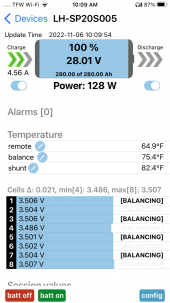acdoctor
Solar Enthusiast
So the growatt charges to a aggregate or total voltage of the battery.Follow-up...
I received another reply from a fellow user, in which he stated my charging voltages were way too low. He then suddenly, before I even had the chance to finish replying, deleted the post. But it led me to believe I really don't know what I'm doing and now I'm even more confused. Oh well, such is life.
But anyway... I'm following up because, as I feared, I believe things are not going well. The SoC reached 100% and the Growatt just kept charging, to the point where I now think the cell balances are getting out of whack! But again, the previous dude said I wasn't charging enough, so now I'm questioning everything again. There are four cells that are being reported as 'iffy', or whatever.
So now I ask, importantly... "What constitutes a LiFePo cell being out of balance?" I mean, how much of a voltage difference constitutes being out of balance. Usually, as stated before, the difference is usually only in the thousandths. But with the continual charge it dropped into the hundredths, and now it's in the tenths - at about 0.15V.
At least however, the Growatt finally decided it's at full SoC and quit charging, only supplying enough to current to run the appliances I have running (overhead lighting, laptops, fridge). But this time I decided just to let everything run its course and just see what happens.
It also occurs to me that what I'm basing everything on is the BMS-Test app that is a companion the the S2 EG4 battery and you're probably not familiar with, so here's a screen shot of this.
View attachment 119340
Here's hoping the insert of the screenshot worked as I am hoping... and I let it go as this. Thanks!
If you have cells that are excessively low then you will need some excessively high to balance out.
Another way to look at it is add all of the individual cells together to get to 28 volts. If all are exactly the same then all are 3.5 volts. If some are 3 volts then some will need to be 3.6 or 3.7 or 3.8 volts so 8 cells add up to 28 and the growatt stops charging. But on the other hand the BMS should stop the charging before any of the cells are allowed to exceed a safe voltage, usually 3.65 volts.
So cells being out of balance is only problematic in the sense that you will need to stop charging at a lower battery voltage than you would if they were well balanced. This stopping charge at a lower voltage is only necessary to avoid tripping the BMS on cell over voltage. Which in turn is a small loss in capacity.
Cells usually stay very close together from 3.0 volts to 3.4 volt. That of course is where most of the capacity is.



